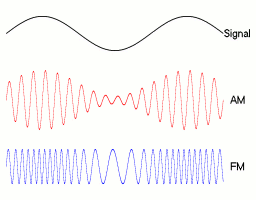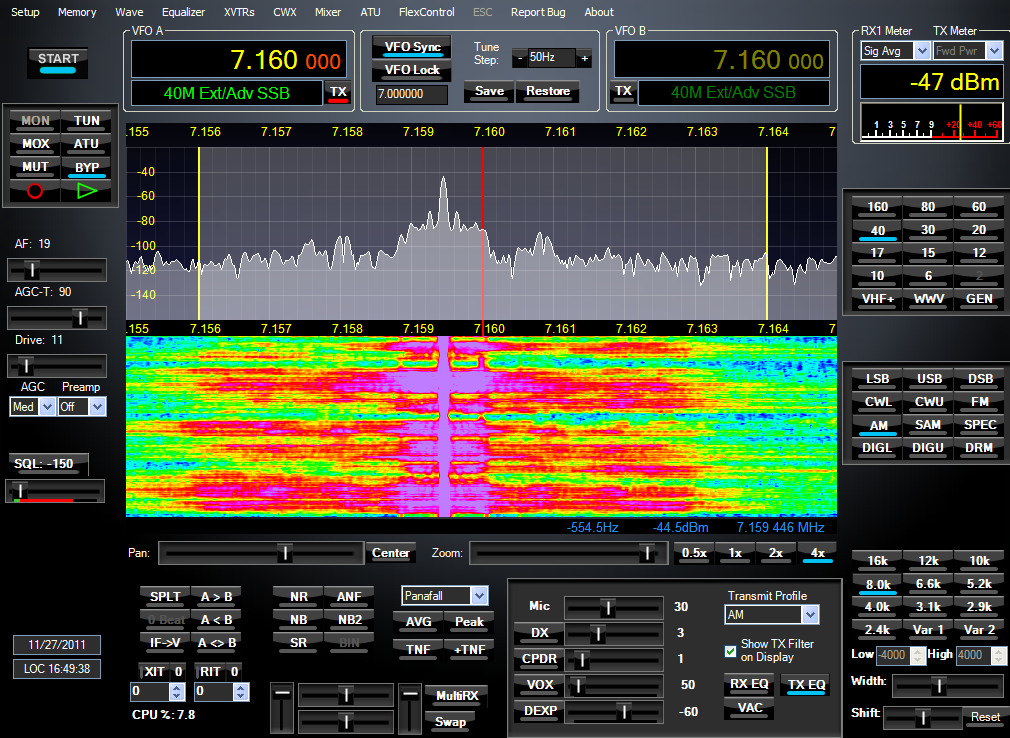W5GW Vintage Operating
I don't believe a vintage station should be created to just look at and admire. Instead, it should be functional and capable of providing reliable communications. While there are many modes that can be applied to a vintage station, I'm currently focused on Amplitude Modulation (AM) and CW. I have already discussed CW in another section of this web site. The following is focused on AM.
AM Operation
When I received my first amateur radio license AM was the the most popular method of voice communications than almost any other mode. In AM the voice signal is impressed upon the radio frequency (RF) carrier in such a manner that the voice information is transmitted at the much higher frequency. In the receiver, the carrier is removed from the signal, and the voice information is restored. It is the same process that is used in AM broadcasts, but it differs from frequency modulated (FM) broadcasting. The animated figure to the right gives a conceptual perspective of the two modulation techniques.

AM/FM Modulation A fundamental difference is that in AM the carrier frequency
remains constant, while in FM, the amplitude remains constant.
AM Station
Here is a station I've dedicated to AM operation on 75, 40 and 10 meters. It consists of a Hammarlund HQ-180C, an EF Johnson Viking II, and a N3ZI Direct Digital Synthesized (DDS) variable frequency oscillator (VFO).
The DDS VFO is not vintage but it allows me the ability to maintain an accurate and stable frequency when operating. The N3ZI web can be accessed here. Link to N3ZI kits. As built, the N3ZI DDS does not have a strong enough signal to drive many of the vintage radios. I built a small buffer amplifier and placed it in the enclosure to get the output up to a volt or so of RF. Here is a schematic of that amplifier. Note it was designed and tested in LTspice. Diagram of buffer amplifier.
Note: the VFO has been replaced with a homemade crystal bank as of July 2013. To see a picture of this and a paper describing it click here. As shown in the figure, I'm also using a Heathkit monitor scope (SB-614) to monitor the quality of my transmitted signal.
Just as in a broadcasting studio, it is important to constanly monitor the quality of the audio that is impressed on the carrier. Two common errors are over modulation (causes distortion and extends the bandwidth of the signal), and undermodulation (when the audio is recovered in the receiver it is weak and difficult to understand).Another lure of AM is the audio quality. While this receiver is not noted for great AM audio, much can be accomplished to improve the audio quality by using a good speaker. Many of the speakers used for amateur communications today are small with limited and tinny sounds. I obtained a 12" Quam speaker and built an enclosure. This is sitting on top of the HQ-170.

Dedicated AM Station Still undergoing restoration.
AM Operation
So what does AM sound like? Today, most of us are spoiled by the high quality FM radio or extremely high quality that comes from a CD or satellite radio. Yet AM, if of sufficient signal strength, and produced by a high quality AM transmitter, can be very pleasing. Here is a short audio recording I made recently on 40 meters of my friend, Darrell, WA5VGO. 40 Meter AM
Here is a spectrum display from my Flex 3000 of the same transmission. Note that his signal to noise ratio was nearly 30 dB over S-9, a very strong signal indeed. To see a larger picture of the AM spectrum click here.
Looking at the spectrum you can see that it contains nearly 8 kHz of spectrum whereas a SSB transmission will typically occupy less than 4 kHz of bandwidth. Yet also note that Darrell has a very good audio response if you listen to the audio recording.

Spectrum of WA5VGO A very strong AM signal.
AM Operation With Modern Equipment
You don't need vintage gear to operate AM. Most of the modern transmitters, receivers, and transceivers will modulate and demodulate AM. If you want to give AM a try, here are some good frequencies to monitor on the 75, 40, and 10 meter bands: 3885 kHz, 7160 kHz, and 29,000 kHz. There are some precautions you need to observe. Keep you AM carrier limited to one fourth of the SSB power rating of the transmitter. Many amateurs have lost their finals by not following this rule. On my Flex 3000, I am able to limit my power output to 10 Watts and use that to drive my linear amplifier to obtain a 100+ Watt carrier output of high quality.